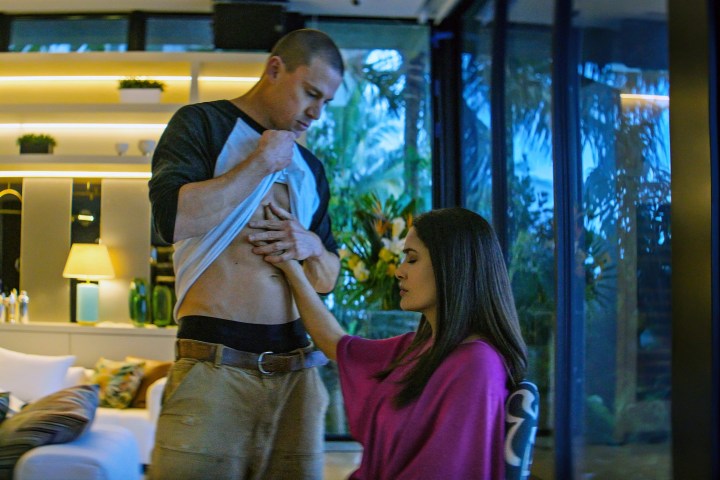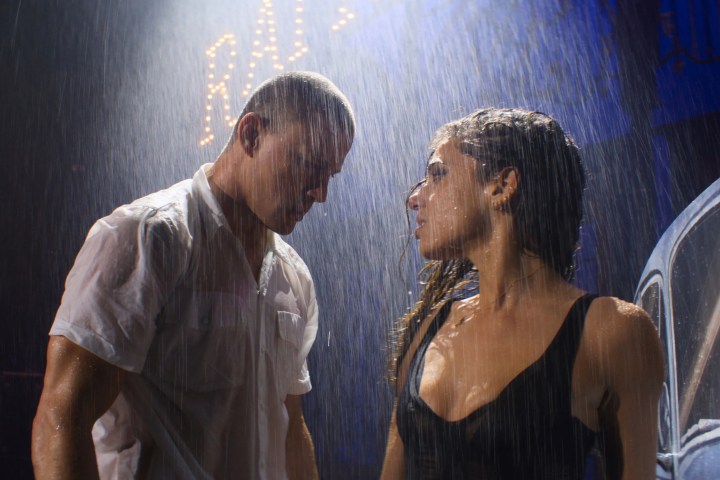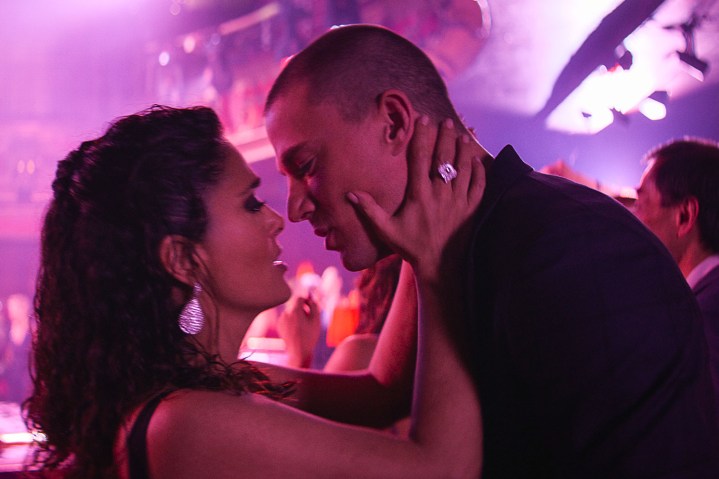
“Magic Mike's Last Dance never matches the exuberant heights of its 2015 predecessor, but it does still manage to deliver a fun, well-choreographed romantic fantasy.”
- Salma Hayek Pinault's charismatic, confident lead performance
- An unforgettable, rain-soaked finale dance number
- Steven Soderbergh's deceptively breezy direction
- Reid Carolin's lackluster script
- The film's unconvincing central romance
- Too many bland supporting characters
Not many Hollywood franchises have evolved as much as the Magic Mike series. The Channing Tatum-led franchise began in 2012 with a Steven Soderbergh-directed drama that was just as interested in showing off the bodies of its male characters as it was in highlighting their economic needs. Three years later, frequent Soderbergh collaborator Gregory Jacobs reinvented the franchise with Magic Mike XXL, which moved the series away from the somewhat dour tone of its predecessor and more toward the lighthearted spirit of a classic road trip comedy.
What Magic Mike XXL, which still ranks as one of the best sequels of the past 10 years, also did for its franchise was inject it with a heightened focus on the actual art of dance and stripping. The film felt, at times, like what would happen if a kindhearted frat comedy had been crossed with a Band Wagon-style, balletic Fred Astaire musical. It’s that admiration for the very act of performing that is most present in this year’s Magic Mike’s Last Dance.
The new film is surprisingly tamer than its two predecessors and feels a bit edgeless at times. What binds Magic Mike’s Last Dance to its franchise’s initial two installments, though, is its intense interest in exploring and celebrating female desire. The film is pure fantasy, and it’s often at its best whenever it actually manages to capture the sexy surreal quality that’s at the center of its story.

When Magic Mike’s Last Dance begins, its eponymous stripper-turned-craftsman, Mike Lane (Channing Tatum), has fallen on hard times. Opening narration informs us that the furniture store he’d spent both Magic Mike and Magic Mike XXL obsessing over was effectively shut down by the COVID-19 pandemic. That unfortunate twist of fate forced Mike to go back to being a full-time gig worker. The film, therefore, picks up with him when he’s working as a bartender at a charity fundraiser in Miami hosted by the very rich future divorcée, Maxandra Mendoza (Salma Hayek Pinault).
Through one of her close associates, Maxandra learns about Mike’s stripper past and offers to pay him for a personal dance. In the moments that follow, Mike gives Maxandra a lap dance better than any she could have ever imagined, which Magic Mike director Steven Soderbergh shoots with equal amounts of exuberance and patience,. The two quickly form a powerful bond. Their dance leads to a night of intimacy, which ends with Maxandra offering to give Mike $60,000 to go to London with her for one month.
When he agrees, he’s surprised to learn that Maxandra has decided to name him the director of a new show based in the very same legendary London theater that she’s won as a part of her divorce proceedings. Maxandra tells Mike that she wants him to put on a show that will make every woman in the audience believe, rightfully so, that she can have “whatever she wants, whenever she wants.” The stripper-centric show that they inevitably produce is both a rejection of the stuffy, misogynistic play that Maxandra’s theater had previously put on and a celebration of intimacy and desire.

To call the film’s story a loose continuation of what’s come before it would be a massive understatement. Outside of Tatum’s Mike Lane, Magic Mike’s Last Dance ultimately has little in common with its 2012 and 2015 predecessors. On the one hand, that aspect of the film allows it to feel freely experimental in a way that so many mainstream Hollywood sequels aren’t allowed to nowadays. On the other hand, Last Dance’s disconnection from the previous two Magic Mike films also leaves it struggling to carve out a genuinely unique identity for itself.
Tatum’s previous male Magic Mike co-stars, including Joe Manganiello and Matt Bomer, only get the chance to appear in one brief Zoom call early on in Last Dance. Their disappointing absence robs the film of the delightful sense of camaraderie that helped elevate both Magic Mike and XXL, and it forces Last Dance to operate without a wide array of memorable supporting characters. That’s not to say that the film doesn’t fill itself with talented male dancers. On the contrary, Mike and Maxandra’s show is largely dedicated to letting its cast of dancers do their thing.
However, very few of the film’s performers actually get the chance to speak, which leaves many of them feeling disappointingly bland and lacking in personality. That fact only makes the absence of characters like Manganiello’s Big Dick Richie and Adam Rodríguez’s Tito feel that much more obvious, as does Last Dance’s intense focus on Maxandra and Mike’s thinly drawn romance.

From their first very scene together, Hayek Pinault and Tatum are able to conjure a sexual chemistry together that helps many of Magic Mike’s Last Dance’s initial sequences pop. Hayek Pinault, in particular, doesn’t let the opportunity to play a confident and passionate character like Maxandra pass her by. She practically owns Magic Mike’s Last Dance from the moment she walks on screen for the first time. Unfortunately, Reid Carolin’s scattered, unfocused script prevents Maxandra and Mike’s romance from ever truly developing beyond their initial attraction to each other, which renders many of Last Dance’s biggest third-act beats strangely weightless.
While the film never manages to conjure either the exuberant energy of its predecessors or the romantic passion that its story demands, Magic Mike’s Last Dance does deliver a memorable visual and sensorial experience. Soderbergh and cinematographer Peter Andrews construct the film out of a series of efficient, snappy takes that not only ensure that Last Dance never slows down for too long, but also allow its numerous dance sequences to truly stand out. That’s particularly true of the film’s opening lap dance, which follows Hayek Pinault and Tatum as they prop each other up against multiple bookcases, shelving units, and pane glass windows.

The film’s opening sequence is only topped by its grand finale, which follows Tatum’s Mike and an unnamed ballerina (played by dancer Kylie Shea) as they dance, slide, and grind onstage together for several minutes underneath a relentless artificial rainfall. The routine is as athletically impressive as anything you’ll likely see on the screen this year, and the way it’s able to feel both exhilaratingly performative and intimately sexual is, frankly, awe-inspiring. It’s one of the best sequences that the Magic Mike franchise has produced, and it’s the closest Last Dance ever comes to feeling like the satisfying final chapter that it’s designed to be.
To put that another way: While Magic Mike’s Last Dance never comes close to stacking up to its predecessors, the film’s celebration of creativity and dance makes it a fitting, if uneven, conclusion to a franchise that has never been afraid to not only bare it all, but also change things up along the way.
Magic Mike’s Last Dance is now playing in theaters.



